|
|
|||
|
(Back to Preceding Week; on to Next Week) |
|
|
|
SPOT-BREASTED THRUSHES
This week at Hilton Pond Center we observed "Take A Child Outside Week"--a national initiative begun this year by educators at the North Carolina Museum of Science--by hosting fifth grade classes from Westminster Catawba Christian School in Rock Hill SC. These budding naturalists, taught by science teacher Caroline Forster, were at the Center for two days of Guided Field Trips. Innately curious, the kids were absorbed as we Socratically helped them determine what bird would make a horizontal row of quarter-inch holes in a Pecan tree or what creature might girdle a twig after laying an egg therein. Spot-breasted thrushes can indeed be confusing, especially in autumn when they all show up at once during migration. However, with a little attention to detail and the persistence exhibited by Ms. Forster's science students, anyone should be able to differentiate among these tricky little thrushes. After all, there are only EIGHT of them that might be expected in the Carolinas.
All text, tables & photos © Hilton Pond Center The first six are the hardest because they're the ones that look most similar. All in this group are basically brown-backed and white-breasted, with varying degrees of spotting. The species most dissimilar is the only one in the group that actually breeds in the Piedmont and therefore one we're most likely to encounter at times other than spring and fall migration. Also our thrush with the biggest and most pronounced spots, we speak here of the Wood Thrush, Hylocichla mustellina, whose species epithet refers to its rusty weasel-like color; the genus name comes directly from two Greek words for "wood" and "thrush."
All text, tables & photos © Hilton Pond Center The Wood Thrush is rather chunky, with a relatively short tail and very pronounced almost-circular dark spots on an otherwise white breast; the breast is sometimes very lightly buffy, especially in juveniles. This thrush's big, dark eye is accented by a complete white eye ring, and its face is marked by tiny black-and-white horizontal barring. One of the Wood Thrush's most useful field marks is its dorsal color--bright rusty on head and upper back but with a duller brown lower back and tail. The Wood Thrush announces its arrival in spring with a haunting flute-like song that is our all-time favorite bird call. In the Carolinas it breeds from the mountains to the Coastal Plain but is less common along South Carolina's southwestern border.
All text, tables & photos © Hilton Pond Center The second of our brown thrushes is also easy to identify, mostly because it is the only one likely to been seen in the Carolinas in WINTER. This is the Hermit Thrush, Catharus guttatus (above and below), which breeds across Canada to Alaska and down the Rocky Mountain chain. Our eastern race is noticeably smaller than the Wood Thrush and has back color that is the reverse of that summer species, i.e., the Hermit Thrush has a duller brown head and back but a bright rusty tail it slowly raises and lowers several times per minute. Hermit Thrushes have moderate but distinct dark spotting on an otherwise white breast; in fact, the species name guttatus means "spotted." A Hermit Thrush's face is dark and essentially unmarked, and its eye has a complete white eye ring.
All text, tables & photos © Hilton Pond Center For the most part, the remaining four brown thrushes occur in the Carolina Piedmont only during migration, although there are scattered records for some of them in summer and winter. (The overwhelming odds are you'll see them only in spring or fall in the Carolinas, so look twice or thrice before reporting one on a Christmas Bird Count.) All four of these birds are placed--along with the Hermit Thrush--in the genus Catharus, from the Greek word for "pure," referring to the purity of their loud, crystal clear songs.
All text, tables & photos © Hilton Pond Center One of the easier brown spot-breasted thrushes to identify has always been the Gray-cheeked Thrush, C. minimus (above and below), but especially in the eastern half of the Carolinas the situation is now complicated. That's because field work on the breeding grounds in New England and Canada's maritime provinces convinced ornithologists that the similar-looking Bicknell's Thrush, C. bicknelli, is actually a distinct species. Gray-cheeked Thrush, as its name states, has a face that is grayish and without specific marks--including, definitively, the lack of any eye ring. There are distinct dark spots against a white breast (sometimes pale buffy), and the back is uniformly olive brown rather than rusty. Bicknell's Thrush looks pretty much the same.
Away from the breeding grounds the best way to determine whether an individual bird is a Bicknell's rather than a Gray-cheeked is to have it in hand for measurements, with Bicknell's being about 10% smaller. North Carolina has at least two definitive banding records while South Carolina has accepted audible records for the species based on its distinctive flight song. We carefully examine every Gray-cheeked Thrush we band at Hilton Pond Center in the hope it might actually be a Bicknell's, but here in the central Piedmont we may be too far west of what appears to be a mostly coastal migrational path.
All text, tables & photos © Hilton Pond Center The Veery, C. fuscescens (above and below)--whose species name is from the Greek for "dusky"--is the smallest of the Catharus thrushes. Its back is completely rusty from head to tail.
All text, tables & photos © Hilton Pond Center The Veery's breast is marked with indistinct spots against a more or less buffy background. The pale wing bar shown above--formed by tips of the secondary covert feathers--is often seen in all species of juvenile spot-breasted thrushes but disappears in adults. The Veery's face tends to be buffy with a similarly colored thin and complete eye ring--which sometimes causes it to be confused with the last of its brown spot-breasted relatives, the Swainson's Thrush.
All text, tables & photos © Hilton Pond Center The Swainson's Thrush is by far the most common of the spot-breasted thrushes at Hilton Pond Center, with 447 banded during the past 26 years (see table in Postscript #1 below). Of these, 89% have been fall migrant birds, many with noticeable fat in their furcular areas--valuable fuel necessary for long-distance migration.
All text, tables & photos © Hilton Pond Center In the photo above, we moistened and smoothed back some of a Swainson's breast feathers to harmlessly reveal a bulging deposit of yellow fat--very different in color from the deep red of the capillary-laden pectoral muscles surrounding it. After taking the photo, we blotted the bird's breast with a towel, dried the feathers, and fluffed everything back into place before sending the thrush on its way. Many Swainson's Thrushes captured around Hilton Pond have bills, feet, or parts of their plumage stained with a decidedly purplish tint, the result of their gorging themselves on our copious crop of Pokeberries. (We have to be very careful when banding these migrant thrushes, lest our clothes and data sheets also take on a purple hue when the birds let go of excess ballast. At the least, we almost always end up with purple hands.)
All text, tables & photos © Hilton Pond Center Swainson's Thrushes, C. ustulatus (from the Latin for "singed color"), show uniform dorsal color (above) that varies from a Veery-like rustiness to the more olive-brown of the Gray-cheeked Thrush. The most distinctive field mark of a Swainson's is its "spectacles"--caused by a pronounced buffy face and wide, equally buffy eye ring. The breast also tends to be buffy, with more or less distinct dark spots. This week when the fifth graders from Catawba Westminster watched us get a spot-breasted thrush from the net, we sat down with a field guide--we always use our trusty, dog-eared Robbins' Birds of North America with beginners--and showed them how to identify the bird by eliminating what it wasn't. They agreed the bird-in-hand couldn't be a duck or a hawk or any other non-passerine in the front half of the book, so that narrowed our search to the back half of the field guide.
All text, tables & photos © Hilton Pond Center As we slowly thumbed through the book, the students ruled out flycatchers and corvids, then swallows and wrens, but when we came to the one-page grouping of brown-backed birds with noticeable spots, the young ornithologists crowded in for a closer look. As they worked down the page--looking at field marks just as we did in our text descriptions above--they were quick to rule out Wood Thrush and Hermit Thrush because of the birds' partially rusty dorsal plumage. Then the kids threw out Gray-cheeked (and, by default, Bicknell's), which narrowed it down to a no-contest between Veery and Swainson's Thrush; it had to be the latter because the students correctly observed the bird we caught had a buffy face and eye ring. These fifth graders were pretty impressive in their ability to look at a bird and differentiate one species from the next based on field marks described in the guide. Needless to say, nothing could make an educator-naturalist happier at Hilton Pond Center than to see another generation of young people interested enough to puzzle out the differences between spot-breasted thrushes--especially during "Take A Child Outdoors" Week. All text, tables & photos © Hilton Pond Center POSTSCRIPT #1: The table below shows the results of 26 years of banding at Hilton Pond Center with regard to "spot-breasted thrushes." The most common species by far has been Swainson's Thrush in fall migration, followed by Hermit Thrushes that spend the winter. Although we haven't run the numbers, we're certain the vast majority of autumn birds--probably 80-90%-- have been young birds hatched that year, while all "spring" birds (except perhaps a few early fledging Wood Thrushes) would be adults. It's possible some of the smaller Gray-cheeked Thrushes captured were actually Bicknell's Thrushes, but because of size overlap in these two species our measurements were not conclusive. (Rest assured we always look very closely at every Gray-cheek!)
All text, tables & photos © Hilton Pond Center
All text, tables & photos © Hilton Pond Center POSTSCRIPT #2: If you carefully read our text above, you'll note we said there are EIGHT spot-breasted thrushes that might be expected in the Carolinas, and we only described six--Wood Thrush and the five Catharus thrushes. The trick is that some spot-breasted thrushes are spotted only when they are juveniles, as in the Eastern Bluebird (above) and American Robin (left) All text, tables & photos © Hilton Pond Center Comments or questions about this week's installment?
Thanks to the following fine folks for recent gifts in support of Hilton Pond Center for Piedmont Natural History and/or Operation RubyThroat: The Hummingbird Project. Your tax-deductible contributions allow us to continue writing, photographing, and sharing "This Week at Hilton Pond." (Please see Support if you'd like to make a gift of your own.)
IMPORTANT NOTE: "This Week at Hilton Pond" is written & photographed You may wish to consult our Index of all nature topics covered since February 2000. You can also use our on-line Hilton Pond Search Engine at the bottom of this page. For a free, non-fattening, on-line subscription to Please refer "This Week at Hilton Pond" to others by clicking on this button: |
If you enjoy "This Week at Hilton Pond," please help support Hilton Pond Center for Piedmont Natural History. It's painless, and YOU can make a difference! (Just CLICK on a logo below or send a check if you like; see Support for address.) |
|
Make credit card donations on-line via Network for Good: |
|
Use your PayPal account to make direct donations: |
|
If you like shopping on-line please become a member of iGive, through which 1,200+ on-line stores from Amazon to Lands' End and even iTunes donate a percentage of your purchase price to support Hilton Pond Center.  Every new member who registers with iGive and makes a purchase through them earns an ADDITIONAL $5 for the Center. You can even do Web searches through iGive and earn a penny per search--sometimes TWO--for the cause! Please enroll by going to the iGive Web site. It's a painless, important way for YOU to support our on-going work in conservation, education, and research. Add the iGive Toolbar to your browser and register Operation RubyThroat as your preferred charity to make it even easier to help Hilton Pond Center when you shop. Every new member who registers with iGive and makes a purchase through them earns an ADDITIONAL $5 for the Center. You can even do Web searches through iGive and earn a penny per search--sometimes TWO--for the cause! Please enroll by going to the iGive Web site. It's a painless, important way for YOU to support our on-going work in conservation, education, and research. Add the iGive Toolbar to your browser and register Operation RubyThroat as your preferred charity to make it even easier to help Hilton Pond Center when you shop. |
|

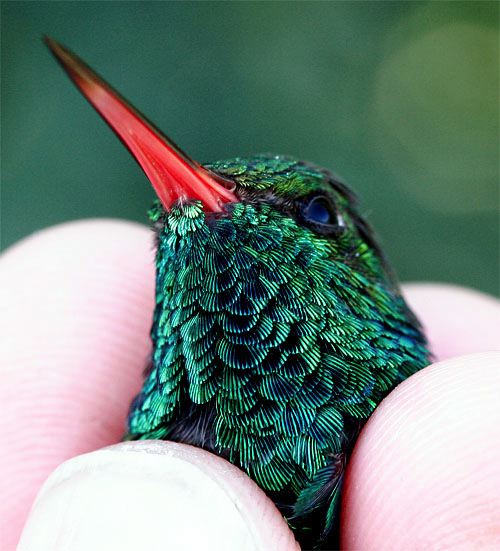 Week One of our annual
Week One of our annual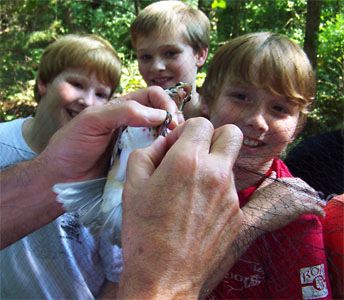 They were even more fascinated to see how we capture birds for banding The group on Day One was very astute in learning to use a birding field guide to figure out the species of birds we caught in a mist net, including an immature male Rose-breasted Grosbeak (above right). Another bird we netted was one that often causes problems for beginning birders, so it was quite rewarding to see these ten-year-olds paying attention to the bird's size, shape, color, and field marks in determining it had to be one of the "spot-breasted thrushes."
They were even more fascinated to see how we capture birds for banding The group on Day One was very astute in learning to use a birding field guide to figure out the species of birds we caught in a mist net, including an immature male Rose-breasted Grosbeak (above right). Another bird we netted was one that often causes problems for beginning birders, so it was quite rewarding to see these ten-year-olds paying attention to the bird's size, shape, color, and field marks in determining it had to be one of the "spot-breasted thrushes."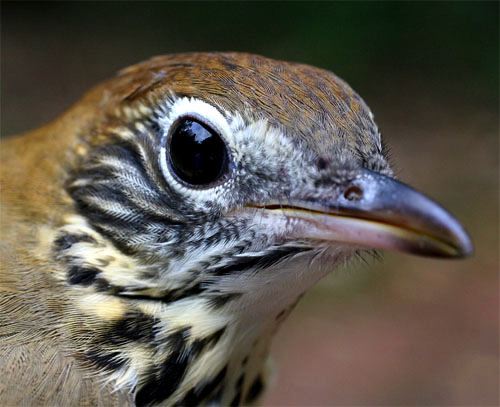
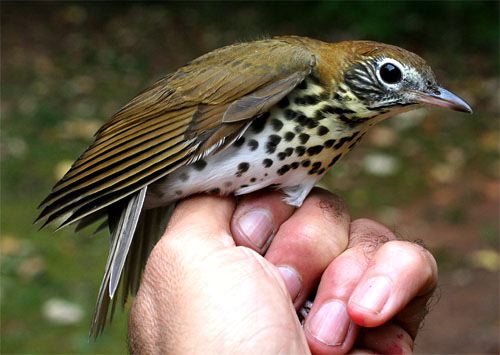
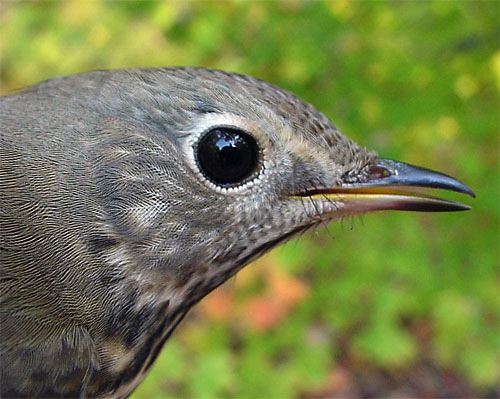
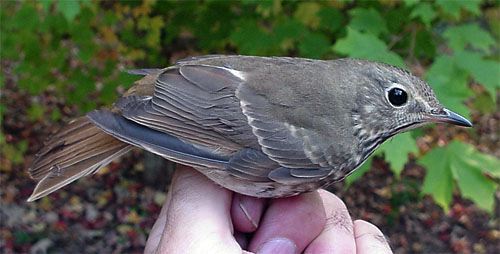
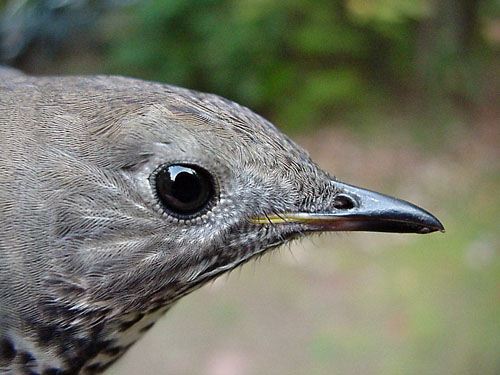
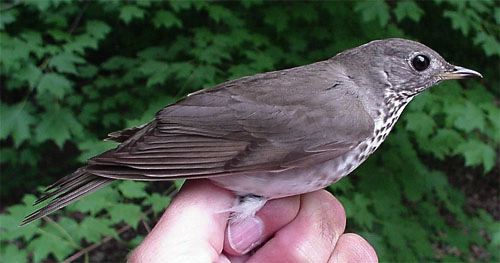
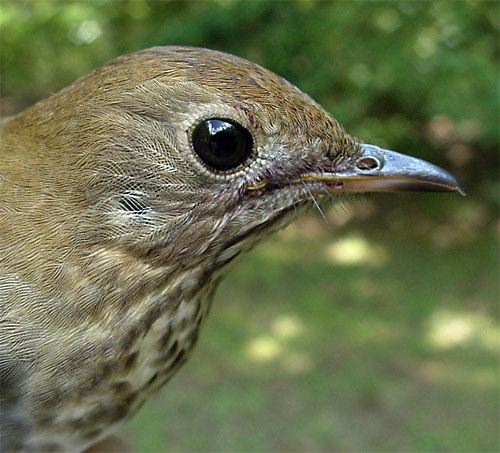
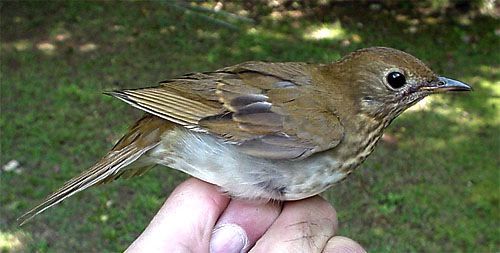
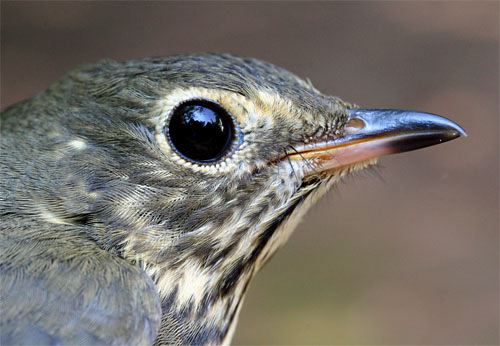
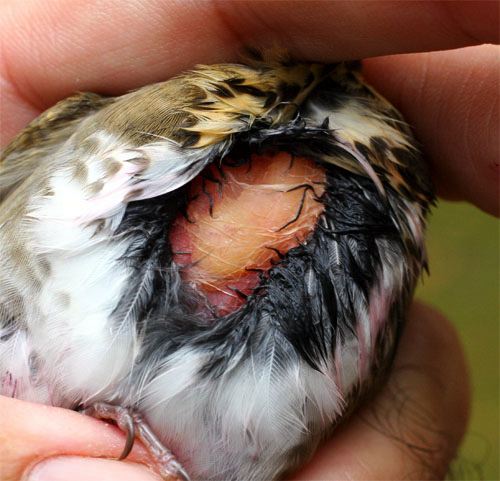
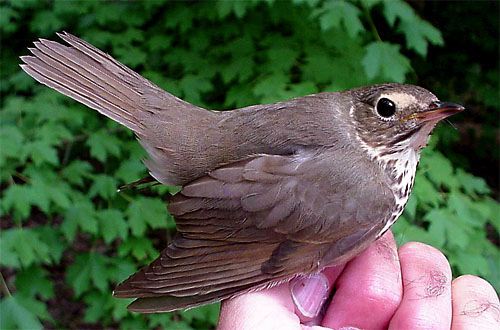
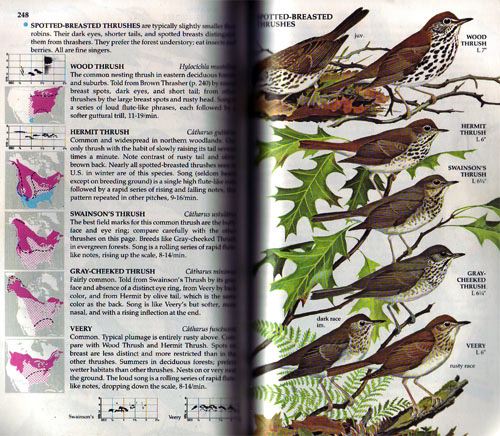
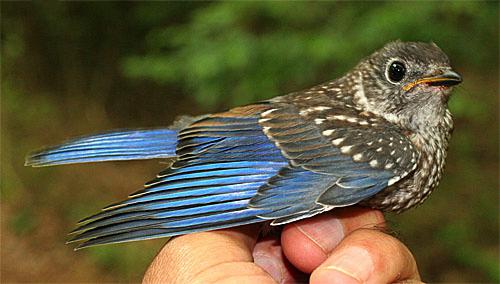
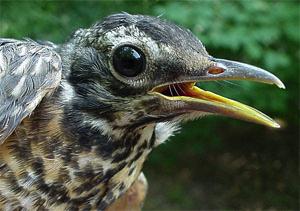 --both of which are common breeders (and year-round residents) across the Carolinas. All these birds are classified together in the Turdidae, the Thrush Family, which also includes four other birds on the official Carolinas list: Varied Thrush, Townsend's Solitaire and Mountain Bluebird (both on the provisional list), and Northern Wheatear. All these also have nestlings with more or less spotted breasts, so technically there could be up to TWELVE spot-breasted thrushes in North and South Carolina.
--both of which are common breeders (and year-round residents) across the Carolinas. All these birds are classified together in the Turdidae, the Thrush Family, which also includes four other birds on the official Carolinas list: Varied Thrush, Townsend's Solitaire and Mountain Bluebird (both on the provisional list), and Northern Wheatear. All these also have nestlings with more or less spotted breasts, so technically there could be up to TWELVE spot-breasted thrushes in North and South Carolina.
 Please report your
Please report your
